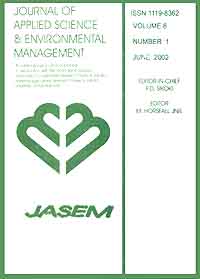
|
Journal of Applied Sciences and Environmental Management
World Bank assisted National Agricultural Research Project (NARP) - University of Port Harcourt
ISSN: 1119-8362
Vol. 15, No. 4, 2011, pp. 649-655
|
 Bioline Code: ja11106
Bioline Code: ja11106
Full paper language: English
Document type: Research Article
Document available free of charge
|
|
|
Journal of Applied Sciences and Environmental Management, Vol. 15, No. 4, 2011, pp. 649-655
| en |
In-vitro Characterization of Optimized Multi-Unit Dosage Forms of Theophylline and its Solid State Characterisation
Uhumwangho, M.U. & Ramana, Murthy K.V.
Abstract
The objective of this study is to compare the drug release profile of an optimized multi-unit dose
(MU) tablet consisting of rapid and slow release components, a formulated sustained released tablet and two brands
of sustained release tablet formulations in the market with a designed model. The fast release component consisted of
conventional granules while the slow release component consisted of wax granules of theophylline. The optimized
MU tablets was formed by mixing the conventional and matrix granules in ratio 1:1 and compressed. Parameters
evaluated were tablet tensile strength and dissolution studies. The optimized formulation was characterized with
Differential Scanning Calorimetry and Fourier-Transform Infrared Spectroscopy. Results showed that the optimized
MU tablets gave dissolution profile that was comparable with that of the designed model. The following were the
dissolution parameters of the optimized MU formulation: the maximum release (m∞) = 91%, prompt release dose
(mp) = 24%, time to attain maximum release (t∞) = 12h and first order release rate constant (k) = 0.20 h-1 which is
comparable with the release data for the model. The other formulations deviated by giving mp and t∞ that were too
low compared with those of the model. There were also no drug/excipient interactions. The indication is that the
prompt release dose was determined not only by the amount of the rapid release components in the MU dose
formulation but also by the amount of sustained release components, attributable to the deformation of granules of
rapid components into that of slow release components during tablet formulation.
Keywords
Multiunit dose tablet, theophylline, Differential Scanning Calorimetry (DSC), Fourier-Transform Infrared Spectroscopy (FTIR).
|
| |
© Copyright 2011 - Journal of Applied Sciences and Environmental Management
|
|
